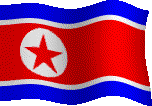




Pyongyang skyline from the
Juche Tower, picture by Peter Deegan
Day 4: Kim Il Sung Won The Korean War
We dropped by the War Victory Memorial, a huge monument to commemorate North Korea’s “victory” in the Korean War. Yes, I also remember Saddam Hussein’s “victory” in the Mother of All Battles in the First Gulf War.
There were many huge sculptures on major episodes of the war, all built in the usual dramatic classical socialist style. One of my favourites was named “Citizens of Seoul welcoming the Korean People’s Army”. (The KPA is the official name for the North Korean Army.) Quite amusingly, the South Korean War Memorial in Seoul also comprised equally monumental sculptures of the same style.
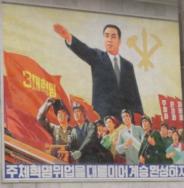
Forward, with the Great Leader!
|
|
|
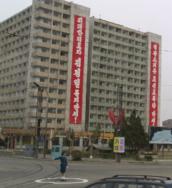
Street scene
|
|
|
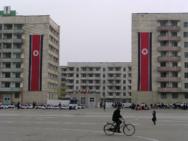
Street scene
|
|
|
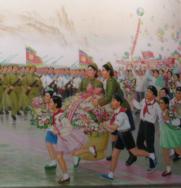
Where are the flowers going to? [No prizes for guessing! Who else?]
|
|
|
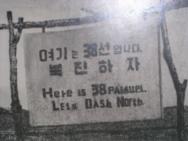
North Korea's "evidence" of US starting the Korean War.
They claimed they found this sign on the southern side...
|
|
|
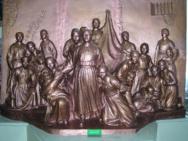
The brave women of Korea
|
|
|
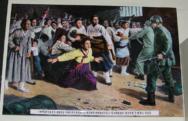
North Korean painting depicting US soldiers assaulting Korean women
|
|
|
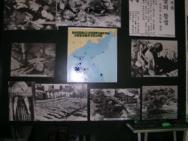
Alleged US atrocities in Korea.
|
|
|
Nearby is the War Victory Museum, a huge complex devoted to the same. In this complex, we were shown a huge treasure trove of not only military hardware and war pictures, but also “evidence” of American launching of the Korean War and American atrocities in Korea.
The Korean War was a brutal military conflict during which between 2 and 4 million civilians died. Both sides committed many atrocities. Many cities changed hands several times as pitch battles were fought throughout most of the Korean peninsula. In recent years, several major massacres committed by US forces in the North were revealed in the American and South Korean press.
Unfortunately, instead of using more reliable and objective sources, the museum squandered goodwill by putting up some dubious display and statistics. Examples were an irrelevant portrayal of an American priest portrayed as a sado-machoist torturer of Koreans and crudely modified photos of US soldiers surrendering. Another display claimed that the Americans murdered 140,000 South Koreans before the Korean War broke out while another publication we found at the museum put the figure at 1 million.
While the display devoted huge sections to the “evidence” of US launching the war and DPRK’s rapid advance through the South, there was little devoted to the radical routing of DPRK forces after UN forces landed in Incheon and their march into Pyongyang and eventually to the Chinese border on the Yalu river. There were instead some mention of the “strategic withdrawal” northwards and the atrocities committed by US forces in Pyongyang.
The most notable omission was the Chinese involvement – the last two years of the war was in reality a war between the US and China. The latter had gotten involved, as they were afraid this was a prelude to an American invasion of China, in support of their Kuomintang allies in Taiwan.
International sources indicated that half a million Chinese soldiers died fighting for North Korea, including Mao Zedong’s son. Eng Teck and I asked about that and were told that only “a few Chinese volunteers” participated in the war. The museum guide added that it was Kim Il Sung’s excellent leadership that turned the tide of the war and led North Korea to “victory”. I think Mainland Chinese visitors would be very upset if they have heard this version of events.
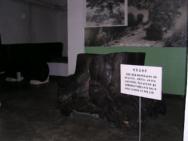
The "Hero Tree", which sheltered and helped to hide North Korean
supply trucks from US attacks.
|
|
|
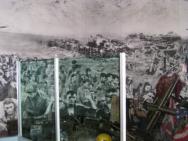
US soldiers "surrendering"
|
|
|
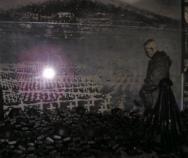
US soldiers "surrendering"
|
|
|
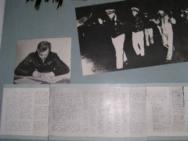
USS Pueblo officers surrendering
|
|
|
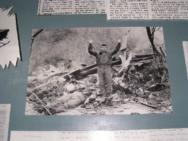
Downed US Bomber - Captured and dead...
|
|
|
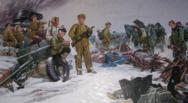
Korean People's Army in winter
|
|
|
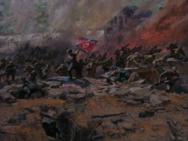
Battle of Daejon
|
|
|
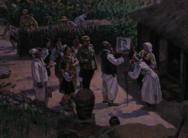
Painting of South Korean villages venerating the Great Leader
|
|
|
Some of the top of the North Korean charts from http://www.geocities.com/Tokyo/Market/2978/music/index-e.html
General Kim Il-Seong
(Kim Il-Seong Jang-gun eui No-rae)
1. On Jang-baek mountains, there are bloodstains.
By Ap-lok river, there are bloodstains.
Those holy stains throw light over the bouquet of free Korea today.
Oh, what a sweet name, General Kim Il-Seong !
Oh, what a glorious name, General Kim Il-Seong !
2. The snowstorm on Man-ju plain, tell a story !
The long night in the jungle, tell a story !
Who is the immortal partizan ?
Who is the peerless patriot ?
Oh, what a sweet name, General Kim Il-Seong !
Oh, what a glorious name, General Kim Il-Seong !
3. He is the benefactor who released the laborers.
He is the great Sun for new democratic Korea.
All people gather to the 20 clause political program.
New spring comes everywhere in Korea.
Oh, what a sweet name, General Kim Il-Seong !
Oh, what a glorious name, General Kim Il-Seong !
 The USS Pueblo was an American spy ship captured by the North Koreans in January 1968 off the coast of the port city of Wonsan. One US officer was killed during the event and 82 men ended up in North Korean captivity. The North Koreans secured a propaganda coup when the US Government was forced to apologise in exchange for the return of the 82 captured men and the remains of the dead officer.
The USS Pueblo was an American spy ship captured by the North Koreans in January 1968 off the coast of the port city of Wonsan. One US officer was killed during the event and 82 men ended up in North Korean captivity. The North Koreans secured a propaganda coup when the US Government was forced to apologise in exchange for the return of the 82 captured men and the remains of the dead officer.
The ship remained in DPRK possession as a war trophy, in an episode so similar to the US spy plane incident off the coast of Hainan Island, China in 2001. I think the Americans would have done the same to North Korean or Chinese spy planes or ships off the coast of California.
We visited USS Pueblo which has become a tourist attraction in Pyongyang. We watched an interesting documentary of the incident, and were shown the bullet holes on the spot where the US officer was killed, as well as the espionage and radio equipment, US Army manuals and maps.
Nearby was where General Sherman, yet another US warship, was destroyed in 1866 and its crew killed. By the 19th century, Western powers had been intruding Korea demanding that the country opened its gates to trade as well as missionaries. French, British, Russian and American gunboats attacked Korean ports from time to time to extract concessions. The Korean imperial court had become hostile to foreigners and banned conversions to Christianity.
In 1866, General Sherman sailed up Taedong river for trade and conversions. Clashes occurred in Pyongyang with Korean authorities. The ship was captured and burned after four days’ battle, and all its crew killed.
The Ri court then had stelae put up across the country to commemorate the event, and they read: “Posterity should remember the unwillingness to fight Western intrusion means reconciliation, and that insisting on peace negotiations means selling the country.”
Whilst there were no clear historic records on who might be responsible for the capture of General Sherman and the killing of the invaders, DPRK authorities had declared the obvious heroes – they claim that Kim Il Sung’s great grandfather was the one responsible, once again proving the heroic lineage of the Kim family!
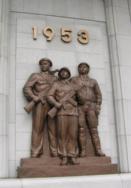
War Victory Memorial
|
|
|
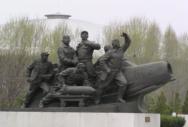
War Victory Memorial: Airmen
|
|
|
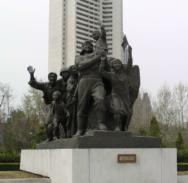
War Victory Memorial: Citizens of Seoul welcoming the Korean People's Army
|
|
|
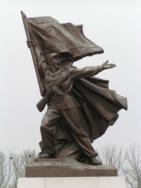
War Victory Memorial
|
|
|
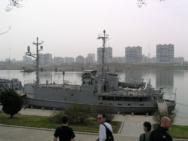
USS Pueblo
|
|
|
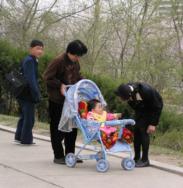
They are human beings too!
|
|
|
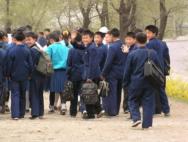
Friendly children
|
|
|
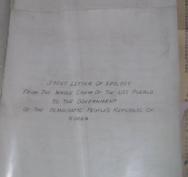
USS Pueblo: Apology letter from officers & men
|
|
|
Another top North Korean song:
Kim_Jeong-Il_Jang-gun-eui_No-rae.mp3
General Kim Jong-Il
1. From Paek-du mountains, 1000km long beautiful realm
All look up to the General and cheer him.
He is the people's leader to inherit the great work of the Sun.
Long live, long live, General Kim Jeong-Il !
2. Millions of flowers on the earth tell us his love.
Blue waves of the ocean sing of his work.
He is the creator of happiness to grow the garden of Ju-che.
Long live, long live, General Kim Jeong-Il !
3. He protects socialism with his courage like steel.
He makes our country famous in the world.
He is the defender of justice with a flag of autonomy.
Long live, long live, General Kim Jeong-Il !
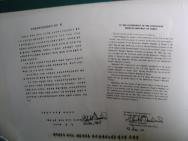
USS Pueblo: Apology letter from the US Government
|
|
|
|
|

Red Kimjonglia and pink Kimilsungia
|
|
|
|
|
|
|
|
Twenty thousand tourists visit North Korea last year, according to our guides, most of whom were from China, in particular, China’s Dongbei region which is just next door to North Korea, which also explained why most of the tour guides speak Chinese. The vast majority of the Chinese tourists visit the casinos of Rajin-Tumen region in the tri-national northeastern corner of the country on the border with China and Russia.
North Korea’s “peak” tourism seasons are spring and summer. The rest of the year is just too cold. Even then, there are times when the tour guides do not have much to do, even during the “peak” seasons.
What do they do then? “We study,” according to Ms Park, and Mr Roh added, “We study in the Grand People’s Study House.” He was referring to the huge national library on Kim Il Sung Square, built to celebrate Kim Il Sung’s 70th birthday in 1982. “And during harvest time, the whole city, including the tour guides, go to the countryside to help the farmers. University students would preach to the farmers the ideas of Juche.”
We visited a school in the afternoon. This was probably a regular feature on all tour programmes to the DPRK. We were shown a biology class, a computer class (with very old Singapore Datamini computers – I hadn’t even seen them for ages at home!) and an ideology class.
The students were no strangers to foreign visitors and were very friendly. However, at the ideology class, it was quite startling that the students didn’t even dare turn their heads to look at us, concentrating instead on a presentation on the life of heroic teenage Kim Jong Il. The walls of the schools were full of murals devoted to, guess what, deeds and lives of the two leaders of the country.
After a walk-around, we were treated to a pleasant song and dance performance by the students during which we were invited to join in the dance. I wonder how much time they devote to such display of “normality” to foreigners. The guide said, “This is an ordinary school where students are children of intellectuals and workers.” What do you think?
Military Circus was next. We watched an amazing display of North Korea’s world-class circus – not surprising since circus arts has always been a core competence of communist countries. In a society where propaganda movies and speeches by the leaders can only distract the people to a limited extent, circus and gymnastic performances are areas that provide some variety to the lives of the people.
Apart from the usual circus and gymnastic stunts, there was a comedy play about how a nasty American soldier was punished for mistreating the “oppressed South Korean people”. The audience, who comprised largely of young military cadres in smart uniforms, had a really good laugh. I wished I understood Korean too!
When the performance ended with all performers appearing on stage to wave farewell, surprise, surprise, a huge projected image of the Dear Leader appeared on the screen. All in the audience stood and clapped. I’m not sure who they were saluting, but, yes, I should thank the Dear Leader for this wonderful performance! Then off we went to Mt Myohyang (meaning “Mountain of Mysterious Fragrance”) on an expressway specially built for tourists. The night was to be spent at the pyramid-shaped Hyangsan Hotel.
Day
5: Electricity for the Great Leader’s Toys
Buy these books!
|
Copyright - Tan Wee Cheng, Singapore, 2004
|







 The USS Pueblo was an American spy ship captured by the North Koreans in January 1968 off the coast of the port city of Wonsan. One US officer was killed during the event and 82 men ended up in North Korean captivity. The North Koreans secured a propaganda coup when the US Government was forced to apologise in exchange for the return of the 82 captured men and the remains of the dead officer.
The USS Pueblo was an American spy ship captured by the North Koreans in January 1968 off the coast of the port city of Wonsan. One US officer was killed during the event and 82 men ended up in North Korean captivity. The North Koreans secured a propaganda coup when the US Government was forced to apologise in exchange for the return of the 82 captured men and the remains of the dead officer.